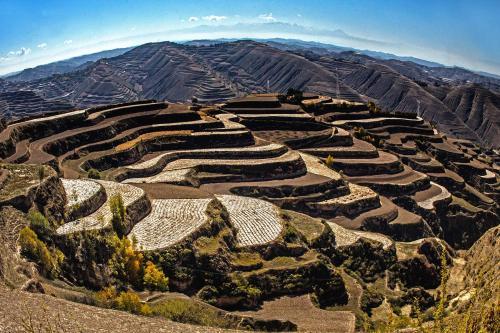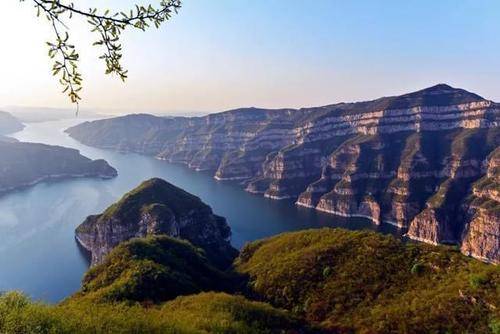Huanghe Sanxia Scenic Area
Huanghe Sanxia (Yellow River Three Gorges) is named after Bingling Gorge, Liujia Gorge, and Yanguo Gorge on the Yellow River within Yongjing. It is a must-visit place on the Silk Road tour and is known as 'The Three Gorges of the Yangtze River in the South, and the Three Gorges of the Yellow River in the North.' The scenic area features a picturesque landscape of high gorges and flat lakes formed by the Liujiaxia Reservoir Dam and three artificial lakes: Bingling Lake, Taiji Lake, and Maogong Lake. Notable attractions include the Bingling Temple Grottoes, hailed as a treasure of Eastern art, the Liujiaxia Hydropower Station, the first million-kilowatt-level hydropower station in New China, and the magnificent Bingling Stone Forest Danxia landform.
Hezheng Ancient Animal Fossil Museum
Hezheng Ancient Animal Fossil Museum is a national second-level museum, officially established in 2003. The museum is divided into two phases, with a building area of 8,000 square meters and a total area of 65 acres. It houses over 30,000 various ancient animal fossils, classified into three classes, eight orders, and 150 genera and species, including more than 50 first-level items, over 180 second-level items, and more than 350 third-level items. Currently, there are exhibitions such as the 'Hezheng Four Major Ancient Animal Fossil Exhibition' and the 'Hezheng Four Major Ancient Animal Ecological Restoration Exhibition,' showcasing over 1,500 exquisite ancient animal fossils representing the four major ancient animal groups at different times.
Jishishan Bao'an Ethnic Folk Culture Museum
Located at the entrance of Jishixiong Pass, west of Mengda Tianchi, with an altitude ranging from 1800 meters to 3300 meters. The gorge is filled with lush mountains, steep cliffs that appear as if carved by knives and axes; dense shrubs, strange rocks scattered throughout the valley, clear streams flowing at the bottom, and waterfalls spanning across; the vegetation is lush, the scenery is beautiful, serene and pleasant, truly a natural wonder. The scenic area is home to many precious wild plants: cordyceps, codonopsis, angelica, coptis, etc. Situated at the junction of the Qinghai-Tibet Plateau and the Loess Plateau, on the desolate and majestic rocky land, the Dadun Gorge Bao'an Ethnic Folk Culture Ecotourism Park is a green gem, emitting a gentle glow. It is a unique tourist destination for natural sightseeing and experiencing ethnic customs.
Songmingyan Scenic Area
Songmingyan National Forest Park is located in the Taizi Mountain forest area, 25 kilometers south of Linxia Prefecture, Gansu Province. The park covers an area of 2666 hectares and includes the Songmingyan Scenic Area, Yaoshui Gorge Water Recreation Area, Balu Valley Alpine Botanical Garden, Huaishanzi Ridge Forest Landscape Area, and Xiaoxia Leisure Resort Area.
Lianhua Mountain Forest Park
Known as 'Baima Mountain' and 'Mountain of Merit' by the Tibetan people, Gansu's Lianhua Mountain has been a popular site for rain prayers and wishes since ancient times, revered by Tibetans as a 'holy land'. Nearby 'Ama Zhoucuo' (Ye Sea) attracts a large number of tourists. Lianhua Mountain, a famous mountain in ancient Taozhou, has a main peak of 3578 meters, a width of about 2 kilometers from north to south, and a length of about 4 kilometers from east to west, with a unique mountain shape. The steep cliffs are surrounded by countless ancient pines and cypresses, vines, and grasses. This 'lotus flower' of a mountain blooms amidst a sea of greenery, clustered peaks, and waves of clouds, making one marvel at the wonders of nature. It has the grandeur of Mount Tai, the peril of Mount Hua, the uniqueness of Mount Huang, the beauty of Mount Lu, the tranquility of Mount Qingcheng, and the elegance of Mount Emei. Located 50 kilometers south of Kangle County, 168 kilometers north of Lanzhou, 177 kilometers west of Hezuo, and 170 kilometers east of Dingxi, it is well-connected by roads and is a national AAAA-level nature reserve and a popular summer tourist destination.













